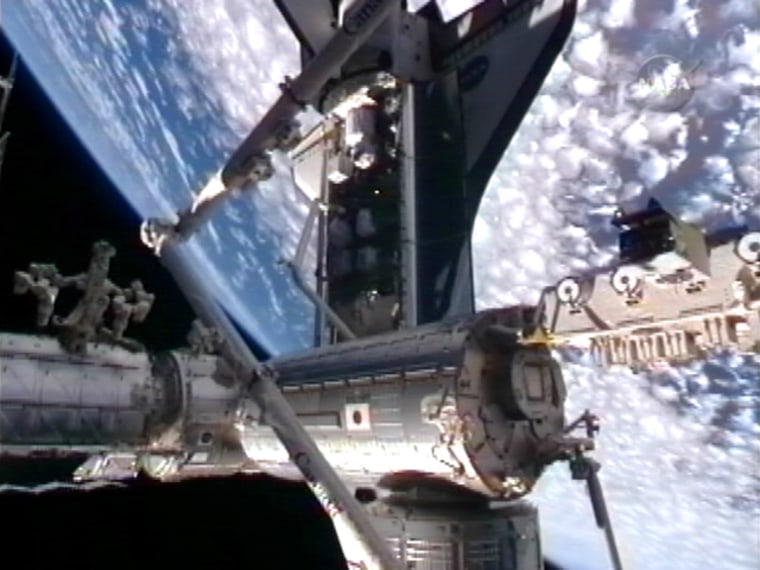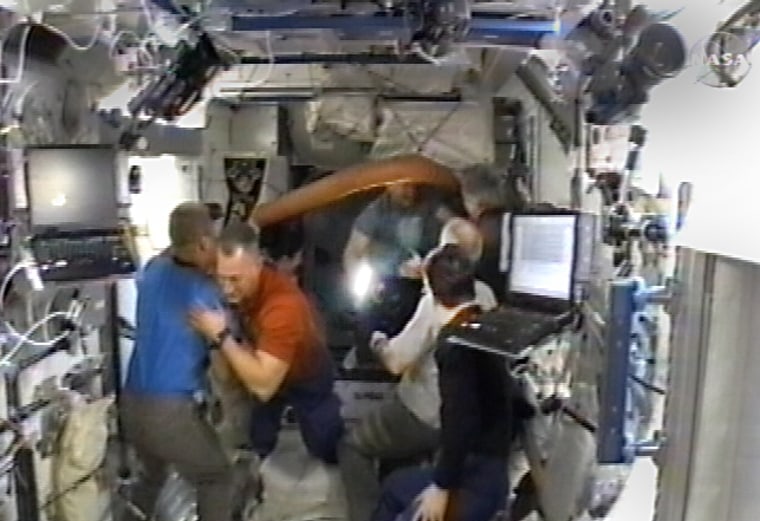The space shuttle Atlantis and its crew of six arrived at the International Space Station Wednesday to drop off some massive spare parts for the orbiting laboratory.
The two vehicles linked up at 11:51 a.m. ET as the two spacecraft flew 220 miles (354 kilometers) above Earth. After sealing the link between them, astronauts opened the hatches at 1:29 p.m. ET.
"We're crashing the party," Atlantis commander Charlie Hobaugh radioed to the waiting station crew when the shuttle was about a mile away.
"We're looking forward to seeing you guys," station astronaut Jeff Williams replied.
Atlantis launched Monday carrying more than 27,000 pounds (12,246 kilograms) of cargo for the space station, including a pair of massive carrier platforms laden with large spare parts for the orbiting laboratory. The spares, which include huge gyroscopes, pumps and other gear, will be installed at the station during three spacewalks planned for the 11-day space mission.
Belly flop
About an hour before docking, Hobaugh flew Atlantis through a back flip called the rendezvous pitch maneuver, which affords the station a detailed view of the shuttle's underbelly.
Inside the station, NASA astronauts Williams and Nicole Stott took several hundred photographs of the shuttle's heat shield to be beamed down to Mission Control. Engineers will analyze the imagery for any signs of damage the orbiter may have suffered during launch.
The move is standard practice after the space shuttle Columbia was damaged in 2003, when foam fell from the shuttle's external tank during launch and hit the orbiter's sensitive heat shielding. The damage led to the devastating loss of Columbia and its seven-astronaut crew.
So far NASA has found no major cause for concern from first readings of data taken during an exhaustive scan of the shuttle's heat shield Tuesday. Engineers will continue to pore over that data and the new photos to be sure the shuttle is safe to ride back through Earth's atmosphere to the ground.
"Preliminarily, we don't have any significant issues," LeRoy Cain, head of Atlantis' mission management team, said late Tuesday.
Returning crewmember
After Atlantis' docked time at the station ends, Stott will return back home with the STS-129 crew.
"I hear you have someone up there looking for a ride home," Hobaugh said as Atlantis approached the station. Williams joked that Stott hadn't yet decided whether to stay in space or return to Earth.

"Tell her we all bathed, we're OK," Hobaugh said.
Stott has been living aboard the station since late August as part of the outpost's six-person crew. She is the last astronaut scheduled to be rotated on and off the station using a NASA shuttle before the fleet is retired, in the next year or so.
Stott and her crewmates have been tackling some glitches with the station's systems.
A 150-pound (68-kilogram) device used to turn astronaut urine into pure drinking water is broken and will have to be returned to Earth on Atlantis. The station's water processing assembly is also experiencing problems.
Neither glitch is expected to pose any concern during Atlantis' weeklong stay at the space station, Cain said.
Just hours after Atlantis arrived, astronauts transferred one of the carrier platforms from the shuttle's payload bay to the station. Meanwhile, veteran spacewalker Mike Foreman and first-time spaceflier Bobby Satcher looked ahead to the mission's first spacewalk, scheduled for Thursday. Foreman and Satcher plan to install a spare antenna and complete other station maintenance tasks during six and a half hours of extravehicular activity.
On Wednesday evening, the two astronauts will sleep in the station's Quest airlock in a so-called "campout" to purge their bodies of nitrogen. The procedure will help the spacewalkers avoid developing the bends while working in their spacesuits.
More on international space station | urine recycling
